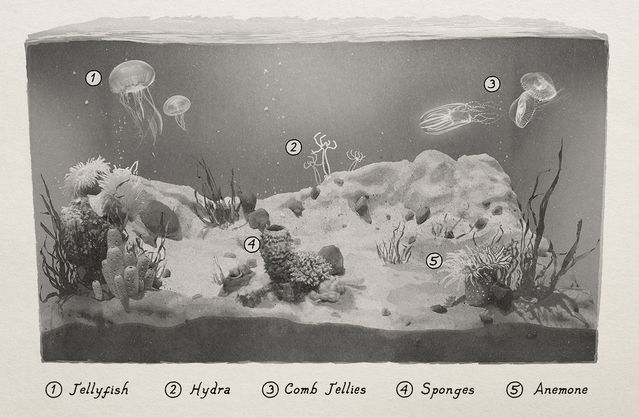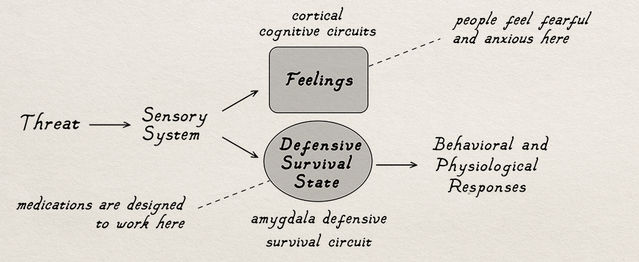Fear
How Deep Do We Go?
Behavior, mind, and the 4-billion-year history of life.
Posted October 18, 2019 Reviewed by Jessica Schrader
I have a new book called The Deep History of Ourselves: The Four-Billion-Year Story of How We Got Conscious Brains. It offers a novel perspective about how behavior and mind fit into the long history of life, and I thought I would revive my blog to share some ideas and themes from the book.
In this post, I’ll summarize what prompted me to write The Deep History of Ourselves and what it’s all about. But before I jump into the details, let me say a few words about the book itself, which has some novel features.
For starters, the chapters are concise thoughts or meditations on a single topic. Most are about 2,000 words and only take up about three pages of text in the book. This makes it easy to pace yourself as we climb down from our branch of the tree of life to its beginning, and then ascends back up to our branch. And to help get the points across, I've included numerous original illustrations, done in a kind of late 19th-century naturalist style, by the artist Caio da Sliva Sorrentino (Figure 1).

Why Did I Write a Book on the History of Life?
Evolutionary biology is not my forte. So let me explain why I took this project on.
I’ve worked on how the brain detects and responds to danger for almost 40 years. My research helped identify the amygdala a key hub in the neural circuitry that helps protect humans and other animals from being harmed in threatening situations. But through loose talk by me and others in this field, the amygdala came to be known as the brain’s fear center. Previously I posted here about why “The Amygdala Is Not the Brain’s Fear Center,” arguing that it is wired by evolution to detect and respond to threats, but that fear is a conscious experience that is cognitively assembled in cortical circuits. (More about that later in this and future posts.)
One of the things discovered about the amygdala is that the plasticity molecules it uses to learn about and respond to danger are very similar to those found in invertebrates, like slugs and bugs. So how did these distinct groups, separated by hundreds of millions of years of distinct evolutionary history, end up with the same molecules?

Genetic studies show that the plasticity molecules shared by these two groups were handed down from their common ancestor, an early bilateral worm (the so-called last common bilateral ancestor) living more than 600 million years ago (Figure 2). These worms, in turn, got their molecules from an ancestor they shared with jellyfish-like organisms, which in turn got theirs from an ancestor they shared with sponges, the oldest animals alive today (Figure 3).
Animals are one of three multicellular groups: plants and fungi are the other two (see Figure 1). Through complicated processes explained in the book, each of these multicellular organisms evolved from a single-cell ancestor belonging to the group called Protista. Of particular interest to us here is the subgroup known as protozoa, from which animals and their nervous systems evolved.

Protozoa have some of the plasticity genes and molecules that animals do. But unlike animals, protozoa don’t have nervous systems. Nervous systems are collections of many, many cells that work with other systems that are also made up of many cells. Yet, despite being single-cell organisms, protozoa have complex behaviors. In fact, to stay alive, they do some of the same things we do each day: detect and respond to danger, find and incorporate nutrients and energy sources, balance fluids and ions, and reproduce. And they use learning to make these activities more efficient.
An important implication is that a nervous system is not needed to behave, or even to learn and remember. In fact, bacteria, the oldest living organisms, and part of the evolutionary past of all other organisms, also behave in these same ways, and also seem to be able to learn.
Behavior thus seems to be as old as life itself. In other words, detecting danger, incorporating nutrients, balancing fluids and ions, and reproducing are things that the first cells, living 3.7 billion years ago, had to do to make it through the day so that they and their kind could persist.
In a very fundamental way, life is simply about not being dead. It is a process that prolongs the inevitable outcome of not existing long enough to reproduce so that additional life can exist. And behavior is a key way that organisms help themselves persist.
Behavior, in short, did not arise as a tool of the mind. It arose, and remains, a part of life’s survival toolkit. Mental control of behavior is a recent outcome. And no matter what our conscious intuitions tell us, mental control of behavior is a relatively minor part of what behavior is fundamentally about.
What Are the Implications for Understanding Who We Are?
When animals engage in defensive, energy management, fluid balance, and reproductive behaviors by fleeing, eating, drinking, and mating, scientists and laypeople alike often intuit that these activities are an expression of underlying psychological states—consciously felt experiences such as fear, hunger, thirst, and sexual pleasure. In doing so we project our own experiences onto other organisms. Given how ancient these activities are, and how they arose long before nervous systems, we should probably be more judicious assuming that mental states made possible by our kinds of nervous system are present in animals that have different kinds of nervous systems.
The perils of using intuitions to understand our behavioral past are illustrated by considering how it plays out in the context of fear. When you are in the presence of danger, you typically feel afraid and do things to protect yourself (run away for example). Because the mental state (the feeling) and the response (running away) often go hand in hand, we naturally think they are entwined in our brains—that fear is what causes us to run. And because the brain systems that control these behaviors are shared with other animals, they must have the kinds of feelings we have when they behave the way we do when in danger.

There is no doubt that the brain circuits that control defensive survival behaviors in other mammals also controls similar behaviors in humans. In fact, amygdala defensive survival circuits can be thought of as continuing the survival lineage started at the beginning of life some four billion years ago. But as I explained in the earlier post, and elaborated on in the book, these are not the circuits that make conscious emotional experiences like fear. Fear, the experience, in my view, is the awareness that YOU are in harm’s way. And this is a product of cognitive circuits involving your cerebral cortex, which has some features that no other animal group, not even other primates, possess.
Recognition that the circuits that control our survival behaviors are different from those that assemble our conscious emotional experiences allows us to see our connection to the deep history of life in a new way. Like all species, we are similar to the species from which we evolved, but are also, by definition, different. And to fully appreciate our uniqueness, we have to be as precise as possible about both our similarities and differences with other species, using science, not intuition, to draw the conclusions.
Lagniappe
In South Louisiana, where I grew up, there’s a Cajun word, “lagniappe,” which means a little something extra. Deep History has that—I composed a suite of songs to go with the book. These are about life, both in the biological and a psychological sense of the term. Freely stream or download Songs of Life here.
References
LeDoux, Joseph E. (2019) The Deep History of Ourselves: The Four-Billion-Year Story of How We Got Conscious Brains (Viking, 2019)




